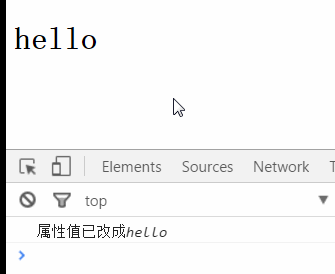监听属性值变化
如果需要监听属性值变化可以通过给observer赋值一个回调函数。
<say-Hello></say-Hello>
<dom-module id="say-Hello">
<template>
<h1>{{say}}</h1>
</template>
</dom-module>
<script>
Polymer({
is:'say-Hello',
properties:{
say:{
type:String,
value:'hello',
observer:'attrChange'
}
},
listeners:{
'click':'setAttr'
},
setAttr:function(){
this.say = 'attr';
},
attrChange:function(){
console.log('属性值已改成' + this.say);
}
})
</script>

当属性值发生改变时,就会触发这个回调函数,注意只有你一开始写了value这个属性就会触发一次,另外如果值没有改变也是不会执行的。
可以在listeners里面写事件,值为一个回调函数,写法和js一样,去掉on。
另外发现attrChange函数里面的第一个值为say
attrChange:function(e){
console.log(e);
console.log('属性值已改成' + this.say);
}

这种方法只能观察一个属性,如果需要观察多个属性的变化,可以用更为复杂的observers
<say-Hello></say-Hello>
<dom-module id="say-Hello">
<template>
<h1>{{userName}}</h1>
</template>
</dom-module>
<script>
Polymer({
is:'say-Hello',
properties:{
userName:String,
age:Number,
sex:String
},
attached:function(){
this.userName = '老王';
this.age = 25;
this.sex = '男';
},
observers:[
'updataSay(userName,age,sex)'
],
updataSay:function(userName,age,sex){
console.log(userName,age,sex);
}
})
</script>
observers值是一个数组,数组里面可以写回调函数, 'updataSay(userName,age,sex)'意思是当userName&&age&&sex都改变的时候才会执行这个方法。

如果只需要监听age和sex改变时就发生可以这样写。
updataSay(age,sex)
如果只写一个,那么和observer是一样的。
监听一个对象的属性变化
<say-Hello></say-Hello>
<dom-module id="say-Hello">
<template>
<input value="{{user.name::input}}">
</template>
</dom-module>
<script>
Polymer({
is:'say-Hello',
properties:{
user: {
type: Object,
value: function() {
return {'name':'请输入内容'};
}
}
},
observers:[
'userNameChanged(user.name)'
],
userNameChanged: function(name) {
console.log('new name: ' + name);
}
})
</script>

监听数组的值变化
<x-custom></x-custom>
<script>
Polymer({
is: 'x-custom',
properties: {
users: {
type: Array,
value: function() {
return [];
}
}
},
observers: [
'usersAddedOrRemoved(users.splices)'
],
usersAddedOrRemoved: function(changeRecord) {
if(!changeRecord)return;
console.log(changeRecord);
},
ready: function() {
this.push('users', {name: "Jack Aubrey"});
},
});
</script>

通过传递splices我们可以查看数组里面的详细信息
index:指数,push的当前值
removed: 删除的数量
addedcount:插入的项目数。
object:项目
type:类型
完。